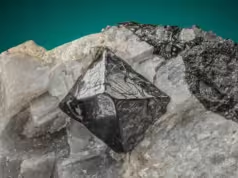



An important rock-forming mineral, orthoclase is the potassium-bearing end member of the potassium sodium feldspar solid-solution series. It is a major component of granite its pink crystals give granite its typical color. Crystalline orthoclase can also be white, colorless, cream, pale yellow, or brownish red. Orthoclase appears as well-formed, short, prismatic crystals, which are frequently twinned. It may also occur in massive form. Moonstone is a variety of orthoclase that exhibits a schiller effect. Pure orthoclase is rare some sodium is usually present in the structure. Specimens are abundant in igneous rocks rich in potassium or silica, in pegmatites, and in gneisses. This mineral is important in ceramics, to make the item itself and as a glaze.
Name: From the Greek for straight and fracture, in allusion to the cleavage angle.
Polymorphism & Series: Dimorphous with microcline; forms a series with celsian.
Mineral Group: Feldspar (alkali) group; (Al,Si) commonly only partially ordered.
Contents
Chemical Properties of Orthoclase
| Chemical Classification | Silicate mineral |
| Chemical Composition | KAlSi3O8 |
Physical Properties of Orthoclase
| Color | Colorless, greenish, greyish yellow, white, pink |
| Streak | white |
| Luster | Vitreous, pearly on cleavage surfaces |
| Cleavage | Has perfect cleavage on {001} and good cleavage on {010}. Cleavages intersect at 90°. It can be difficult to see cleavage in thin section due to orthoclase’s low relief. |
| Diaphaneity | Translucent to transparent |
| Mohs Hardness | 6 (defining mineral) |
| Specific Gravity | 2.55–2.63 |
| Crystal System | Monoclinic |
| Tenacity | Brittle |
| Parting | On {100} {110} {110} {201} |
| Fracture | Irregular/Uneven, Conchoidal |
| Density | 2.55 – 2.63 g/cm3 (Measured) 2.563 g/cm3 (Calculated) |
Optical Properties of Orthoclase


| Color / Pleochroism | Non-pleochroic |
| Optical Extinction | X^a = 6°-14°, Y^c = -13° to 21°, Z = b |
| Twinning | Common as Carlsbad, Baveno and Manebach. |
| Optic Sign | Biaxial (-) |
| Birefringence | 0.004 |
| Relief | Low |
Occurrence
The common feldspar of granites, granite pegmatites, and syenites. In cavities in basalts; in high-grade metamorphic rocks and as a result of potassic hydrothermal alteration; also authigenic and detrital.
Uses Area
- Ceramics
- Glass
- Abrasives
- Gemstones
- Mohs scale mineral
Association
Albite, muscovite, biotite, hornblende,” schorl, beryl.
Distribution
Widespread. Fine examples from St. Gotthard, Ticino, and at Val Giuv, Tavetsch, GraubuÄnden, Switzerland. In the Zillertal, Tirol, Austria. From Baveno, Piedmont, in the P¯tschtal, Trentino-Alto Adige, and at San Piero in Campo, Elba, Italy. At Epprechtstein, Bavaria, Carlsbad, Bohemia, and Manebach, Thuringia, Germany. From Cornwall, England. In Russia, from the Mursinka-Alabashka area, near Yekaterinburg (Sverdlovsk), Ural Mountains. In the USA, from Maine, at Paris and Buck¯eld, Oxford Co; at Cornog, Chester Co., and Blue Hill and Lieperville, Delaware Co., Pennsylvania. In California, from the Pala and Mesa Grande districts, San Diego Co.; in Colorado, on Mt. Antero, Cha®ee Co.; at Crystal Pass, Goodsprings, Clark Co., Nevada. From Guanajuato, Mexico. At Tanokamiyama, Shiga Prefecture, Japan. Gem crystals from Ampandrandava, Fianarantsoa, and Itrongay, near Betroka, Madagascar.
References
- Bonewitz, R. (2012). Rocks and minerals. 2nd ed. London: DK Publishing.
- Handbookofmineralogy.org. (2019). Handbook of Mineralogy. [online] Available at: http://www.handbookofmineralogy.org [Accessed 4 Mar. 2019].
- Mindat.org. (2019). Orthoclase: Mineral information, data and localities.. [online] Available at: https://www.mindat.org

































